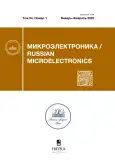Influence of boundary conditions on transport in a quantum well
- Autores: Romanov D.N.1, Kuznetsova I.A.1
-
Afiliações:
- P. G. Demidov Yaroslavl State University
- Edição: Volume 54, Nº 1 (2025)
- Páginas: 26-33
- Seção: MODELING
- URL: https://journal-vniispk.ru/0544-1269/article/view/294487
- DOI: https://doi.org/10.31857/S0544126925010047
- EDN: https://elibrary.ru/GIKJQH
- ID: 294487
Citar
Resumo
The problem of the electrical conductivity of a conducting channel at the boundary of a heterojunction or in a MD transistor is solved, considering the quantum theory of transfer processes. The thickness of the layer can be comparable to and less than the de Broglie wavelength of the charge carriers. The behavior of charge carriers is described by the quantum Liouville equation. The influence of surface scattering of charge carriers is considered through the Soffer boundary conditions. An expression for the electrical conductivity is obtained and its dependence on the strength of the transverse electric field and the roughness parameter of the boundary of the conducting channel with another semiconductor is analyzed. A comparative analysis of theoretical calculations with experimental data is carried out.
Palavras-chave
Texto integral
Sobre autores
D. Romanov
P. G. Demidov Yaroslavl State University
Autor responsável pela correspondência
Email: romanov.yar357@mail.ru
Rússia, Yaroslavl
I. Kuznetsova
P. G. Demidov Yaroslavl State University
Email: romanov.yar357@mail.ru
Rússia, Yaroslavl
Bibliografia
- Pal S., Valentin S.R., Ludwig A., Wieck A.D. Quantum Confinement in High Electron Mobility Transistors. 2017. P. 65–88. https://doi.org/110.5772/intechopen.68374
- Matteo M., Carlo S., Idriss A., Matteo B., Marcello C. GaN-based power devices: Physics, reliability, and perspectives // J. of Appl. Phys. 2021. V. 130. № 18. P. 181101. https://doi.org/10.1063/5.0061354
- Aadit M.N.A., Kirtania S.G., Afrin F., Alam Md.K., Khosru Q.D.M. High Electron Mobility Transistors: Performance Analysis, Research Trend and Applications. 2017. P. 45–64. https://doi.org/10.5772/67796
- Volcheck V., Stempitsky V. Mobility of a two-dimensional electron gas in the AlGaAs/GaAs heterostructure: simulation and analysis // ITM Web Conf. 2019. V. 30. P. 08005. https://doi.org/10.1051/itmconf/20193008005
- Longobardi G., Udrea F. On the Time-Dependent Transport Mechanism Between Surface Traps and the 2DEG in AlGaN/GaN Devices // IEEE Transactions on Electron Devices. 2017. V. 64. № 11. P. 4415–4423. https://doi.org/10.1109/TED.2017.2752859
- Miller E.J. et al. Trap characterization by gate-drain conductance and capacitance dispersion studies of an AlGaN/GaN heterostructure field-effect transistor // J. Appl. Phys. 2000. V. 87. P. 8070–8073. https://doi.org/10.1063/1.373499
- Khadar R.A., Liu C., Soleimanzadeh R. and Matioli E. Fully Vertical GaN-on-Si power MOSFETs // IEEE Electron Device Lett. 2019. V. 40. № 3. P. 443–446. https://doi.org/10.1109/LED.2019.2894177
- Soffer S.B. Statistical Model for the Size Effect in Electrical Conduction // J. Appl. Phys. 1967. V. 38. № 4. P. 1710–1715. https://doi.org/10.1063/1.1709746
- Elinson M.I., Volkov V.A., Lutskij V.N., Pinsker T.N. Quantum size effect and perspectives of its practical application // Thin Solid Films. 1972. V. 12. P. 383–397. https://doi.org/10.1016/0040-6090(72)90102-2
- Munoz R.C., Arenas C. Side effects and charge transport in metals: Quantum theory of the resistivity of nanometric metallic structures arising from electron scattering by grain boundaries and by rough surfaces // Appl. Phys. Rev. 2017. V. 4. P. 011102. https://doi.org/10.1063/1.4974032
- Arenas C., Herrera G., Tavera E.M., Munoz R.C. The breakdown of Moore’s law induced by wes Anderson localization and by side effects in nanoscale metallic connectors // Mater. Res. Express. 2021. V. 8. P. 015026. https://doi.org/10.1088/2053-1591/abd422
- Charfeddine M., Belmabrouk H., Zaidi M., Maaref H. 2-D Theoretical Model for Current-Voltage Characteristics in AlGaN/GaN HEMT’s // J. Mod. Phys. 2012. V. 3. № 8. P. 881–886. https://doi.org/10.4236/jmp.2012.38115
- Kuznetsova I.A., Savenko O.V., Romanov D.N. The influence of Fermi surface anisotropy and the charge carrier surface scattering kinetics on the electrical conductivity of a thin metal film in the view of the quantum size effect // JPCS. 2021. V. 2056. P. 012018. https://doi.org/10.1088/1742-6596/2056/1/012018
- Kuznetsova I.A., Savenko O.V., Romanov D.N. Influence of quantum electron transport and surface scattering of charge carriers on the conductivity of nanolayer // Phys. Lett. A. 2022. V. 427. P. 127933. https://doi.org/10.1016/j.physleta.2022.127933
- Da-Wei Y., Fuxue W., Zhu Z., Jianmin C., Gu X. Capacitance and conductance dispersion in AlGaN/GaN heterostructure // J. Semicond. 2013. V. 34. P. 014003. https://doi.org/10.1088/1674-4926/34/1/014003
- Xiao J., Hong Z., Roungxiu Z., Zhao J. Interface roughness scattering in an AlGaAs/GaAs triangle quantum well and square quantum well // J. Semicond. 2013. V. 34. № 7. P. 072004. https://doi.org/10.1088/1674-4926/34/7/072004
- Shrestha N.M., Li Y., Suemitsu T., Samukawa S. Electrical Characteristic of AlGaN/GaN High-Electron-Mobility Transistors With Recess Gate Structure // IEEE Transactions on Electron Devices. 2019. V. 66. № 4. P. 1694–1698. https://doi.org/10.1109/TED.2019.2901719
Arquivos suplementares















